Sauerkraut, either you love it or you hate it. I love it, but my household has mixed emotions about it. It takes several weeks to ferment your cabbage, and to make it you need lots of cabbage and pickling salt.
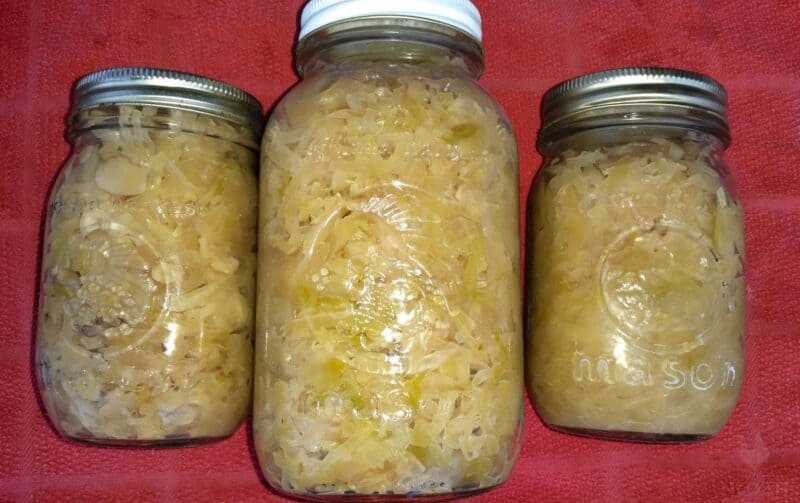
Table of Contents:
What is Sauerkraut?
Sauerkraut is much simpler than it sounds, it is just finely chopped cabbage and salt that you ferment and, optionally, you can afterwards.
Why Does It Need to Ferment?
Let’s go over the importance and reason for allowing your cabbage to ferment. To ferment means to allow the food to set and go through changes. In the way of sauerkraut, lactic acid is produced. The environment that is needed in a fermentation process for sauerkraut is salinity (salt), temperature, and time.
- Salinity. Salt pulls water from the cabbage to make a brine. The cabbage sits in the brine as it is being made. The brine is where the good bacteria grow and live and the bad bacteria dies.
- Temperature. You need a consistent temperature of 68 to 72 degrees Fahrenheit (20 22 Celsius) to achieve a good environment for fermentation.
- Time. The process of fermenting takes time, usually two weeks or so.You need to be patient and check on your product every few days.
The Salty Truth
The amount of salt you use determines the amount of time it takes to ferment. If you use too much salt the fermentation process is slow. Too little salt and the fermentation process goes too quickly, and the sauerkraut turns out mushy. You can use any salt for fermenting so long as it doesn’t contain iodine or any other additives.
The brine that is best for fermenting your cabbage is a 2% brine ratio for a crispy and tangy sauerkraut. To achieve this brine ratio you need to measure out your cabbage and salt ratio.
You need 1 ¾ pounds of cabbage to 1 tablespoon of salt. This is what it takes to fill a quart jar to ferment in, if you are a beginner or if prefer this method. I like the way it turns out so I do this method on a much larger scale, in several layers in a crock.
I grew cabbage this year in my garden, but it was too wet and didn’t do very well. To the Farmer’s Market I went, and I purchased two heads for $1 from an Amish family set up there. Score!! I bought 20 heads of cabbage, and that made me almost 30 pounds when I was finished cutting it up.
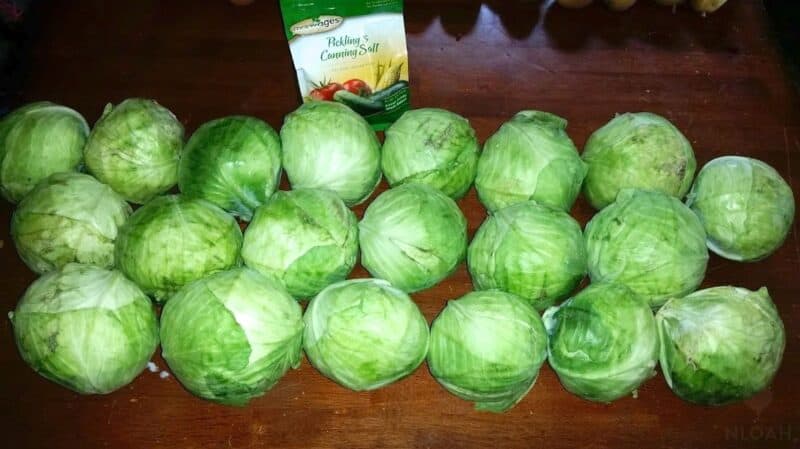
Sauerkraut Ingredients
- Cabbage
- Pickling Salt
- Kitchen Scale
- A crock of some sort
Needed Tools
- Plastic wrap
- Bowls
- A means to chop (I used a mandolin)
- 1 tablespoon measuring spoon
- Muscles
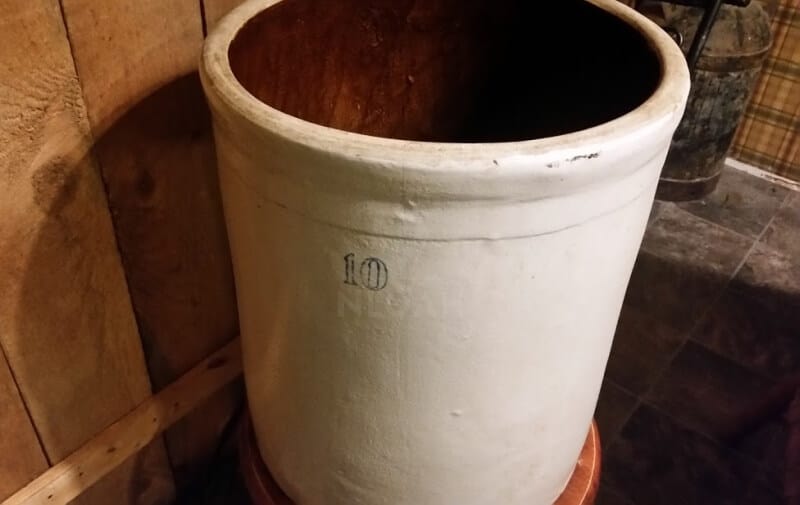
A partner will make the process so much quicker and easier. I recruited my oldest daughter and my husband. We all split tasks of shredding, to weighing, and measuring and smashing. They also made it more fun as we talked and joked the whole time.
Preparing the Cabbage to Ferment
- Clean the cabbage by removing the outer leaves and anything that doesn’t look good, and discard that to the compost pile.
- Cut your cabbage in half and remove the core.
- Start chopping or shredding the cabbage.
- Once you have shredded all of it or enough to get some of the next step done then zero out the kitchen scale with a bowl on it.
- Measure the cabbage in the bowl to weigh 1 ¾ pounds.
- Put this into your crock.
- Sprinkle one tablespoon of salt over the layer, and smash down with your hand or fist.
- Continue layering in the crock until you are done with the cabbage.
- Be extra sure that you smash and press each layer well. The end of a coffee cup works well at this point.
- Cover the cabbage and salt mix with plastic wrap. Completely cover and press it in on the sides.
- Place a weight of some sort or a dish over the plastic wrap to keep it weighed down.
It is VERY important to be sure that you smash down each layer of cabbage and salt. Use your fists or a dish or a weight of some sort. The smashing removes any air that can be between the cabbage. There must be no air for the cabbage to ferment.
I covered my crock with a stone pizza pan to prevent anything from being able to get into it, and to help conceal it when it starts to smell. Covering it also helps to keep the air out. Be sure to check on the cabbage every few days.
When you check on it you must replace the plastic wrap, do not reuse the old. When you check your kraut if you have a film, nasty liquid layer you can spoon that out and then recover with new plastic wrap. Be certain that the cabbage is always covered by brine as it is fermenting.
You cannot ferment your cabbage in anything metal, so a crock or glass are your options. Also, never add new cabbage to an already fermenting batch.
It Is Time
The wait is over, it has been about three weeks in the fermentation process. The cabbage looks like sauerkraut and tastes amazing. My husband also taste tested and approved. The kraut is now ready to be enjoyed.
You can leave the sauerkraut in the crock and just use as needed, but it needs to be placed in a cool room. The temperature needs to be between 32 to 40 degrees Fahrenheit (0 to 4 degrees Celsius). If you do not have a cold room that maintains this temperature, you will need to can it.
This is the fermented sauerkraut that is in the crock. It can be stored this way if I had a cold room; it would just need to be covered:
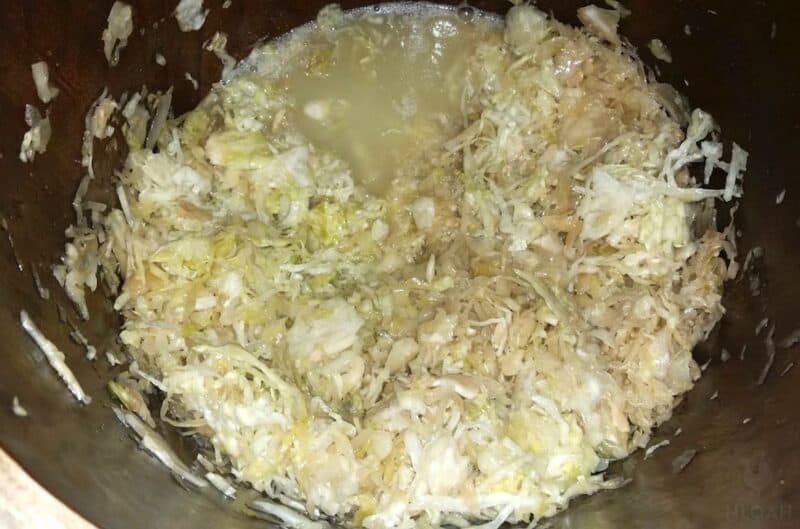
Extra Brine to Can
If your sauerkraut doesn’t have enough brine you may need to add more to your jars. To do this you simply need water and pickling salt. One quart of water to every 1 ½ tablespoons of salt is the correct ratio.
- In a large pan measure your water and your salt
- Stir mixture until dissolved
- Turn heat to low to keep brine hot for hot packing with the heated sauerkraut
How to Can Homemade Sauerkraut
Sauerkraut is a high acid food so you only need to water bath can it. This is a very simple and easy process to be able to better store your amazing sauerkraut.. It is also able to be preserved into the serving sizes that your family can use, such as pints or quarts.
Canning Tools
- Water bath canner
- Jars of desired size
- Lids and bands
- Pot to heat the kraut in
- Water for canner and keeping jars hot to pack
- Jar lifter
- Air bubble remover
- Jar funnel
- A sturdy spoon for stirring and packing the kraut
- A towel to wipe rims with
- A dry towel to place finished sauerkraut to cool
Now that you have everything gathered it is time to get busy canning.
Step By Step Instructions
- Inspect jars for knicks or cracks.
- Wash jars and lids as directed.
- Fill the canner with water and turn the heat to high.
- Place jars in the water canner to keep hot for packing.
- Place the fermented kraut in a pot on the stove. Just do amounts you can handle.
- Heat the kraut on low to simmer but not boil.
- Add extra brine, if needed, from your brine mixture. My fermented cabbage is very juicy so I probably won’t need much.
- Pack hot jars with heated kraut up to ½ an inch of headspace.
- Add extra brine if needed to jars still leaving ½ an inch headspace at the top of the jar.
- Wipe the rims clean.
- Apply lids and bands to the jar.
- Place hot jars of kraut into the heated boiling canner.
- Once the canner water is boiling cover with a lid and set the timer. Pints process for 15 minutes. Quarts process for 25 minutes.
- Once the time is up, remove the jars with the jar lifter and set them on the dry towel to cool.
- Allow 24 hours to cool.
- Remove bands and store the sauerkraut in your pantry.
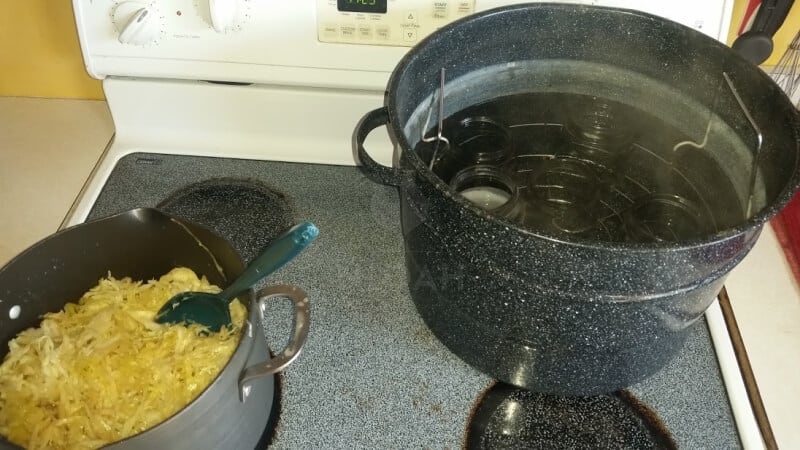
Now you can enjoy your own sauerkraut year-round. The hardest part about fermenting and canning sauerkraut is the wait.
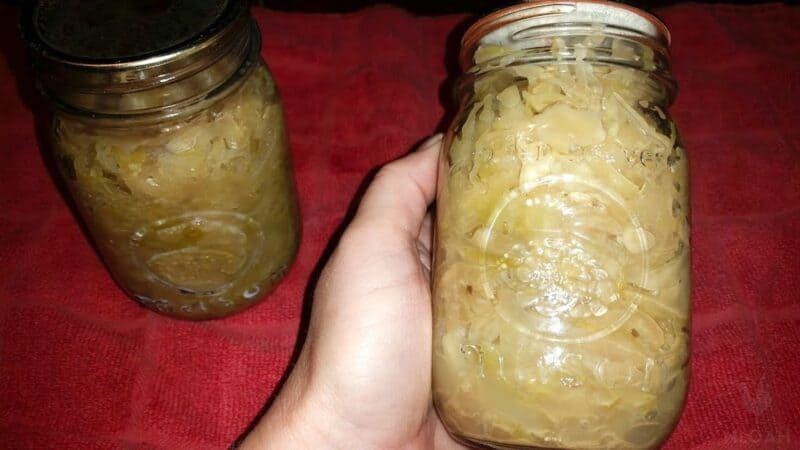
Now that the wait is over, enjoy your work in various meals. You will prefer the taste of home fermented sauerkraut over store-bought after you have had your own.


Sarah Rodriguez is a homesteading wife and mother of five living in Appalachia. She grew up in a homesteading and logging family.
She and her husband Arnie work their 10-acre homestead together alongside their growing family. Sarah honed her self-reliance skills through 4-H and FFA at an early age and is now teaching her children to live off the land, raise livestock, and the importance of both sustainability and frugality.

Doesn’t the canning process negate the benefits of fermentation?
As soon as I saw sauerkraut in the title I had to run to the kitchen and eat a few forksfull…
Awesome, I know just how you feel!